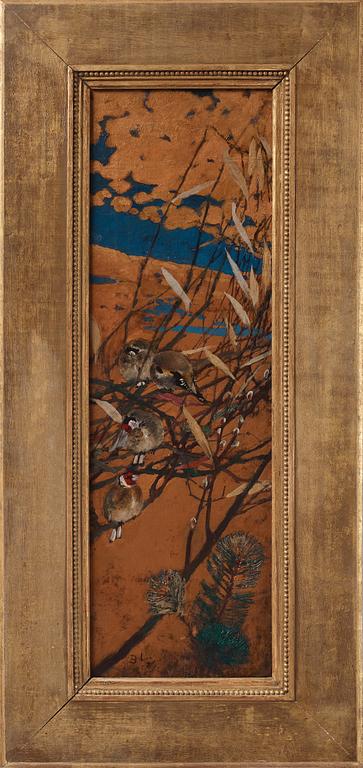Bruno Liljefors
"Steglitsor" (European goldfinches)
Signed B.L and dated -89. Canvas 87 x 28 cm.
Alkuperä - Provenienssi
Åmells Konsthandel, Stockholm
Private Collection
Näyttelyt
Prins Eugens Waldemarsudde, Stockholm, "Bruno Liljefors", September 20th 1996 - January 6th 1997.
Göteborgs Konstmuseum, "Bruno Liljefors", January 25th - May 25th 1997.
"Anders Zorn, Bruno Liljefors, Carl Larsson" catalogue number 43, Åmells Konsthandel, 20 november - 19 december 1997, cat. no 3.
Kirjallisuus
Allan Ellenius, "Bruno Liljefors. Naturen som livsrum", 1996, upptagen i katalog på sid 226.
Muut tiedot
"Steglitsor" from 1889 is an excellent example of how, in the last decades of the 19th century, Bruno Liljefors became influenced by Japanese painting. In 1854 Japan had opened its borders to the world, which resulted in the spread of Japanese objects, such as wood cuttings and ceramics, to the West. The passionate interest in Japan and Japanese art that then emerged became known as ‘Japonisme’. During the 1880s Japanese influences began to find their way into Swedish art. Many Swedish artists had first encountered Japanese art and objets d’art in Paris and had been highly struck by them. The Scandinavian artists in the artist colony in Grez-sur-Loing began exploring new ways of composing images. In 1919 Carl Larsson wrote how "as an artist Japan is my country of birth". They would paint narrow images in portrait size, go close up to their subject and use surprising crops.
It was in this spirit of Japonisme that Liljefors painted "Steglitsor". The way Liljefors cropped the image into a long and narrow surface, and placed the subject in the foreground with the landscape or sky as a clearly separated background, was a common stylistic technique that emerged from this trend. The manner in which the artist painted the sky in a decorative, almost surface-like way could also be associated with the same movement.



























































